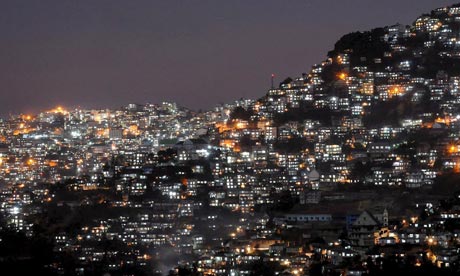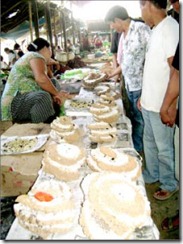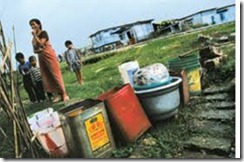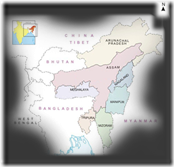
BJP activists take out a peace rally in Guwahati.
By Patricia Mukhim
Comparisons are odious but they are the only way in which human beings and institutions can progress. Unless there is something better to compare with, how can we measure our successes or failures? How do we know that we have made some headway in our human endeavour?
The seven states of the Northeast which have been tagged together as homogenous entities have always felt that Kashmir is the apple of India’s eye while they are orphans.
The damage control exercise launched by an obliging Centre during the recent crisis in the Valley was illustrative of the concern for that troubled paradise, once the beautiful kingdom of Maharaja Hari Singh. People in the Northeast have nursed their hurt and pain at this obvious display of favouritism.
Normally this should not happen in a country whose rulers possess a depth of knowledge, political acumen and social discernment about governing a nation of disparate voices and ethnicities. Unfortunately, this nation does not have people of that calibre.
The social apathy and political insouciance was evident during the 68-day blockade of National Highway 39, called by a section of Naga organisations to express their grievances against the government of Manipur
This blockade resulted in an economic crisis of unspeakable dimensions which also affected the Naga-inhabited areas.
It was like cutting the nose to spite the face. The Nagas of Manipur knew this but had claimed they had no other way to bring the Manipur government to its knees. After the 68-day period, the Centre began talking tough because the media had made it uncomfortable for the government in New Delhi to remain unconcerned.
The blockade was lifted on condition that it would be re-imposed if the government failed to respond to the demands of the Nagas of Manipur. And indeed the Nagas made good their word. The blockade was re-imposed on National Highways 39 and 53 since August 3 and continues.
The Centre made a feeble attempt to create some sort of forum where things between the parties in conflict would be thrashed out with Delhi acting as the referee. But this failed to pacify the Nagas. They had taken a decision to opt out of Manipur and have stuck to their guns. These are political battles that are expected to last for as long as Naga peace talks are on track.
We are talking here of a 63-year-old problem which seems to defy solution. The Nagas have been hewing at a humungous boulder bit by bit for all of 50 years.
Whether they have made a dent is not the issue here. But it has been 13 years since they officially agreed to talk peace.
Compared to the Naga insurgency, the Kashmir assertion is of fairly recent origin. At least the insurgency bit is.
Perhaps the situation in Kashmir has taken a nosedive after Omar Abdullah assumed charge as chief minister. He is accused of remaining aloof from the people, a characteristic that is typical of a high caste, high-class ruler who lords it over his subjects.
That someone was so piqued as to throw a shoe at the crotchety Omar who seems to be saying all the wrong things could not have done his sagging image a lot of good. And that by a cop!
Kashmir scene
Recently a national media news channel aired a programme that provided the microphone to several young Kashmiris to say what they felt about the present problems of Kashmir and the way forward. Each one who spoke said they wanted a Kashmir that enjoyed its autonomy and was allowed to rule itself. They spoke of political sovereignty without blinking an eyelid. It sounded very much like what the Nagas had been saying for half a century and the Manipuri Meiteis for over two decades. The young Kashmiris who spoke up cannot be accused of being spokespersons of the hardliners who are alleged to be fomenting trouble in Kashmir. They seemed like educated, independent young people with a mind of their own. They all detested the Armed Forces (Special Powers) Act, 1958, and wondered why the Centre continued with this draconian law against its own people.
What they were trying to convey very subtly was that it was easy for “India” to use such draconian laws because the Kashmiris are never really considered “Indians”. Clearly, the Centre’s appeasement policy does not wash with the average Kashmiri because it is seen as a purely political ploy to keep Omar Abdullah in his chair. There is also an obvious disdain by the present generation for politicians across the political spectrum
Fear of what?
Indeed, come to think of it, seldom if ever would a nation once enslaved, use a law enacted by a colonial power and apply that law on its own people after it became a sovereign country and long after that colonial power had left this its soil. Since no part of India is today safer than the Northeast or Kashmir, would the army act be applied so readily anywhere else? What then are the compulsions of India when it comes to Kashmir and the seven states of the Northeast?
Pakistan’s penchant for Kashmir and the issues around that state certainly are trigger points that make India react, often with uneducated responses. But what are India’s fears in the eastern sector? Is China still a threat? Have the ghosts of the past not been exorcised yet? Can any part of the country be kept under a tight leash merely because of the fear of invasion? A fear that is perhaps ill-founded, given the present geo-politico-economic compulsions and the interdependence of nations? If the fear is founded on some well-founded arguments then is it not premature of India to be speaking of the Look East Policy unless it is some kind of red herring intended to befool the people of the seven states.
Maoist threat
Comparisons indeed are odious but there is no doubt that Kashmir not the periphery that the Northeast is. Kashmir is the core of India’s existence as a sovereign country. In this so-called Indian state, the assertions for secessionism are no longer covert.
Every other day, hardened groups owing loyalty either to Pakistan or to a different idea of sovereignty make that call and whip up anti-India sentiments without being held to account.
The only similarity is that Kashmir like the Northeast is also a highly-militarised zone and military brutality is felt there on a daily basis as much as it was in Nagaland and Mizoram in the fifties and sixties.
While Kashmir is always in the eye of the storm, the Northeast has to jolt the Centre every once in while with bomb blasts. The sense of real and perceived neglect is gradually sending the region into a sort of delinquency which could become a fertile ground for Maoism. In the long run this could further dent the image of India. If Maoist violence spreads to the Northeast it will catch on like wildfire. India does not have a policy that is tried and tested and can be applied in the Northeast or Kashmir. Those ruling the roost in Delhi are obsessed with the politics of instant gains. They have no stamina to think of long-term strategies that will yield more sustainable, long-term results.
(The writer can be contacted at patricia17@rediffmail.com)




 Lad Phawa's Fields - now a water storage area
Lad Phawa's Fields - now a water storage area








































